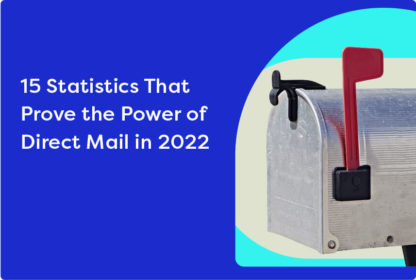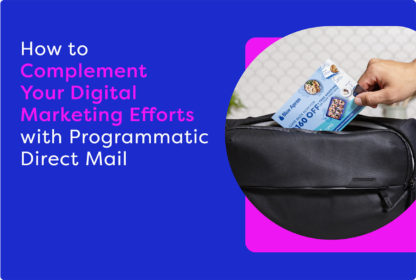Direct mail is a massive, highly effective marketing channel in the United States – and with Programmatic Direct Mail on the rise, we’ve only scratched the surface of its potential and importance.
That was the message from PebblePost CEO Jacob Ross on The Ecom Show podcast with Daniel Budai, founder of the eCommerce retention marketing agency, Budai Media. In the episode, Ross discussed his 20 years of experience, being part of the digital marketing revolution, and the reinvention of traditional offline channels that followed, including Programmatic Direct Mail.
Programmatic Direct Mail uses online intent, purchase, and household data so that marketers can create a more “personalized, relevant experience for consumers” when engaging them at home. With more and more purchase decisions being discussed and made at home, this has become a critical channel for marketers looking to nurture long consideration cycles impact purchase decisions.
Here are five key takeaways from Ross and Budai’s conversation about why Programmatic Direct Mail is thriving, and how you can use it as a stand-alone or to enhance your digital marketing strategies.
1. Customer Data is Critical for Acquisition
Many companies already know a lot about their existing customers, but how can they engage an untapped audience that resembles their best and most valuable customers?
First, by modeling prospecting audiences based on your best customers, like your most frequent purchasers or those with the highest lifetime value. PebblePost uses that data to teach automated machine learning models what traits and behaviors make your best customers your best customers, then helps you find more people that share those characteristics.
“We understand what consumers are interested in, we understand their purchase behavior,” Ross says. “That saves a brand a lot of money because they don’t have to waste time marketing to people who aren’t going to respond.”
But prospecting is only one part of an acquisition program. Marketers need multiple touches along a buyer’s journey to purchase, which is why PebblePost recommends pairing a prospecting strategy with a lower-funnel strategy like retargeting in order to convert in-market consumers.
Unlike basic marketing automation, which uses actions like pressing a button or visiting a webpage to decide who gets an offer, PebblePost’s retargeting captures intent signals from across a brand’s entire website and uses that to qualify and mail website visitors within 24-48 hours of their visit.
And because the audiences are built around households, they are able to suppress existing customers on a 1:1 basis from any acquisition program, ensuring a brand’s budget is only spent on net-new customers.
2. Programmatic Direct Mail Picks Up Where Digital Left Off
The global direct mail advertising business is expected to grow to $76.95 billion in 2023. “It’s huge because it’s hugely effective,” Ross says. One of the great benefits Programmatic Direct Mail has brought to the direct mail space is the ability to match the speed, efficiency, and relevance of digital channels.
Automation and machine learning make it possible for brands to instantly determine the predicted probability that a consumer will convert on an ad, and get a piece of marketing mail printed and out the door in hours – not days or weeks. This allows the brand to continue the conversation during a critical consideration period, essentially picking up where digital left off.
“First class mail takes three to five days to arrive,” Ross says. “And then it could sit on a dining room table for days or weeks. The impression is incredibly high impact, so it’s very complementary to digital channels.”
In fact, according to Mailmen, a household may keep a piece of marketing mail for about 17 days on average. Compare that to the seconds or (at most) minutes they might spend with a digital ad, and the value of that tangible, long-lasting impression is clear.
3. Relevance is Key to ‘Surviving the Sort’
Consumers visit their mailboxes, sort through them, and decide what to keep and what to trash, all within a few seconds. Your goal as a marketer is to make it into the “keep” pile.
“It’s the difference between going to your mailbox and getting something that you feel like is junk mail, and going to your mailbox and seeing an offer in there and saying, ‘I’m actually interested in this and I’m going to bring it into my house,'” Ross says.
Being relevant, both in terms of the content of the offer and the timing, creates a higher propensity for engagement and, ultimately, performance.
4. Scale Matters in Programmatic Direct Mail
One of the inherent benefits of Programmatic Direct Mail is that brands don’t actually have to send as much mail in order to hit their performance goals, because they’re only sending to individuals with the highest propensity to perform a desired action.
But that also means that brands need a large enough data set from which to identify those individuals in order to scale their PDM program. The more available data, the better trained the machine learning models will be, and the better the performance Programmatic Direct Mail will yield.
PebblePost works with brands that have at least 500,000 monthly unique visitors to their website, as a baseline to ensure that there is a large enough audience reaching the brand’s website.
“That’s where we see them making a really big impact with this channel,” Ross says.
5. Know Your Objective with Programmatic Direct Mail
Before spending the time, money, and energy on a Programmatic Direct Mail program, it’s crucial to identify the objectives. Is it a high return on ad spend, or is the focus on driving incremental lift? Does the objective change based on where a consumer is in their lifecycle with a brand?
PebblePost’s technology can project, track, and measure performance based on those specifics—and the more specific, the better the result.
Ross mentions Mejuri’s full-funnel campaign with PebblePost as a case study: the fine jeweler consolidated their ad spend with PebblePost and made sure not to overexpose their customers to ads, which resulted in a long-standing successful partnership.
“We saw the whole funnel generating more loyal, repeat purchases, and the return on ad spend was phenomenal,” Ross says.
You can hear the full conversation between Ross and Budai at LinkedIn.


